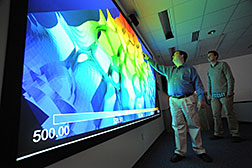- Number 394 |
- August 5, 2013
MOOSE fosters herd of modeling applications

MARMOT developer Michael Tonks, left, and
MOOSE co-developer Derek Gaston discuss
a simulation of nuclear fuel microstructure
evolution.
Although modeling and simulation has now become standard practice in nearly every branch of science, building a useful simulation capability has been daunting because it required a team of software developers working for years with scientists to describe a given phenomenon. The MOOSE (Multiphysics Object Oriented Simulation Environment) developed at DOE's Idaho National Laboratory now enables simulation tools to be developed in a fraction of the time.
Scientists who don't have in-depth knowledge of computer science can now develop an application that they can "plug and play" into the MOOSE simulation platform. In essence, MOOSE solves the mathematical equations embodied by the model. Such a tool means scientists can focus their efforts on the physical science of their field, and MOOSE does the rest. The simplicity has bred a herd of modeling applications describing phenomena in nuclear physics (BISON, MARMOT), geology (FALCON), chemistry (RAT) and engineering (RAVEN, Pronghorn).
The herd members are in various stages of development ranging from recent preliminary results to national recognition as state-of-the-art. MOOSE and its applications are currently licensed for use by 38 domestic and foreign laboratories, universities and companies — a user community that's growing monthly. This success illustrates how exceptional expertise and strategic partnerships converge at INL, the nation's nuclear energy laboratory.
[Nicole Stricker, 208/526-5955,
nicole.stricker@inl.gov]
